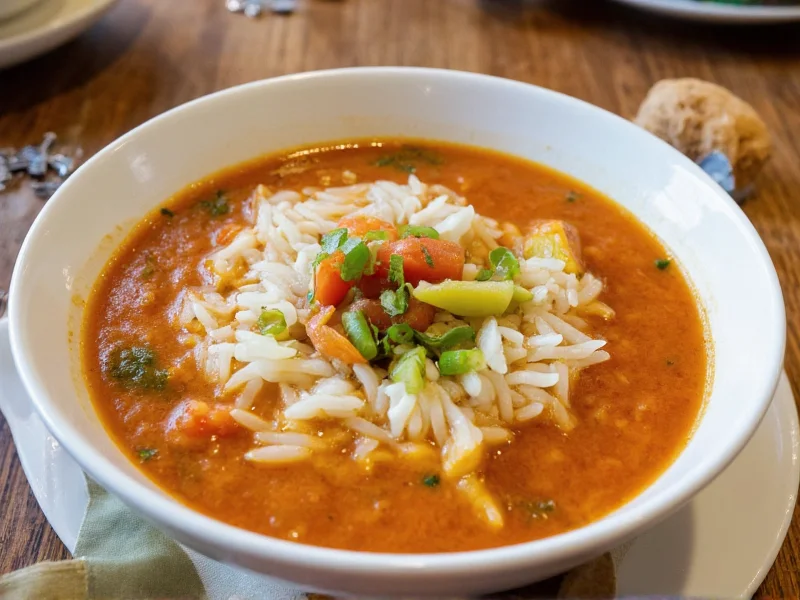Rice soups represent one of the world's most universal comfort foods, appearing in nearly every major culinary tradition with distinctive regional variations. These nourishing dishes combine the neutral base of rice with flavorful broths and complementary ingredients to create meals that are simultaneously simple and complex in their execution. Whether you're seeking traditional Asian rice soup preparation or exploring European interpretations, understanding the fundamentals of rice soup composition elevates both cooking and dining experiences.
The Global Tapestry of Rice Soup Traditions
Rice soups have evolved independently across continents, reflecting local ingredients and cultural preferences. In Asia, congee (China), juk (Korea), and okayu (Japan) represent centuries-old preparations where rice is cooked until it breaks down completely into a porridge-like consistency. Southeast Asian versions like Vietnamese cháo often include proteins such as chicken or fish. Mediterranean regions feature versions like Spanish arroz caldoso, while Italian cuisine offers risotto-based soups that maintain distinct rice grains in a brothy preparation.
Essential Components of Perfect Rice Soups
Creating exceptional rice soup requires attention to several critical elements:
| Component | Key Considerations | Recommended Options |
|---|---|---|
| Rice varieties | Grain structure affects texture and broth absorption | Short-grain for creaminess (sushi rice), medium-grain for balance (Calrose), long-grain for distinct texture (jasmine) |
| Broth foundation | Determines overall flavor profile | Homemade bone broth for richness, vegetable broth for vegetarian options, dashi for Asian preparations |
| Thickening methods | Affects mouthfeel without compromising texture | Rice starch release (simmering time), pureed vegetables, egg ribbons |
| Finishing techniques | Enhances complexity and freshness | Acid components (rice vinegar, lime), fresh herbs, toasted sesame oil |
Nutritional Profile and Health Considerations
Rice soups offer significant nutritional advantages when properly formulated. The combination of rice and broth provides easily digestible carbohydrates with sustained energy release. When enhanced with vegetables and lean proteins, these soups become nutritionally complete meals. Traditional Asian rice soup preparations often incorporate medicinal ingredients like ginger and garlic, which provide anti-inflammatory benefits. For those seeking gluten-free rice soup options, rice naturally meets this requirement when prepared with appropriate broths.
Nutritionists frequently recommend rice soups for digestive health due to their gentle nature on the gastrointestinal system. The soluble fiber from properly cooked rice helps regulate digestion while the warm liquid component promotes hydration. When exploring nutritious rice soup benefits, consider adding leafy greens during the final minutes of cooking to preserve their vitamin content.
Mastering Rice Soup Preparation Techniques
Achieving perfect texture in rice soups requires understanding how different preparation methods affect the final product. For traditional congee-style preparations, the rice-to-liquid ratio typically ranges from 1:8 to 1:12, with extended simmering allowing the grains to fully disintegrate. When preparing Italian-style rice soups that maintain distinct grains, a 1:4 ratio with shorter cooking times preserves texture.
Professional chefs emphasize these techniques for easy homemade rice soup techniques:
- Toast the rice briefly in oil before adding liquid to enhance nuttiness and prevent mushiness
- Add rice to boiling broth rather than cold liquid for more consistent cooking
- Reserve some broth to adjust consistency after cooking, as rice continues absorbing liquid off-heat
- Add delicate ingredients like fresh herbs and greens in the final minutes to preserve flavor and color
Perfect Pairings for Rice Soup Meals
Understanding comforting rice soup pairings transforms these dishes from simple meals to complete dining experiences. In Asian traditions, rice soups often accompany small side dishes called banchan that provide contrasting textures and flavors. Crisp vegetables, pickled items, and protein-based sides create balanced meals. For Western interpretations, crusty bread provides textural contrast while a simple green salad adds freshness.
When considering what rice soups pair well with specific occasions:
- For cold weather: Pair with roasted root vegetables and crusty artisan bread
- For light meals: Serve with steamed bok choy and tofu for complete plant-based nutrition
- For recovery meals: Complement with electrolyte-rich beverages and easily digestible proteins
- For formal presentations: Garnish with edible flowers and serve in warmed bowls
Avoiding Common Rice Soup Mistakes
Even experienced cooks encounter challenges with rice soups. The most frequent issue involves texture problems—either overly mushy or undercooked rice. This typically stems from improper rice-to-liquid ratios or inconsistent heat management. Another common mistake is adding salt too early, which can toughen proteins when included in the soup.
For those exploring healthy rice soup variations, be cautious about overloading with high-sodium ingredients that undermine the health benefits. Instead, build flavor through aromatic vegetables, proper toasting techniques, and strategic acid additions at the end of cooking. When preparing gluten-free rice soup options, verify that all broth components and seasonings meet dietary requirements.











 浙公网安备
33010002000092号
浙公网安备
33010002000092号 浙B2-20120091-4
浙B2-20120091-4